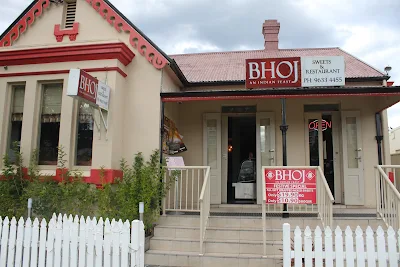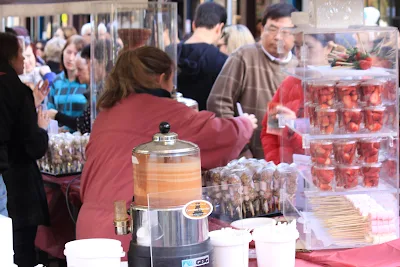Amongst the mandarins, cherries, kiwis and apples, on a winter's afternoon at a large produce store, another fruit stands out - pomegranates. This unique fruit, with a history that relates to the Greeks and Babylon, is rich with folic acid, Vitamin C, Vitamin K, potassium and fibre. The origin of its contemporary name in English is the "seeded apple" in Latin. More importantly, this fruit is packed with antioxidants useful for the prevention of cancer and heart disease. I recall the adage to eat food in as many colours as possible in one day. The bright red pomegranate bits are like gems. They are often used in salads, if not just consumed fresh. It is native from the Caucasian mountains near Iran and Iraq, popularised by the Phoenicians (hence the scientific name Punica Granatum) and extensively used in Arab, Spanish, Turkish, Pakistani and Indian cuisine. The latter has also placed high regard for the pomegranate in Ayurveda medicine. Examples of pomegranate use in the Indian kitchen are in potato and pomegranate salads or other types of raitas, mixed with mueslis, as flavours for ice pops, or in syrups, sauces and marinades.
In my childhood, I knew them as "ladies fingers", crunchy green bean-like rocket shaped vegetables with soft insides and containing those white coloured small seeds. I bit into them when they were cooked and soaked in flavours from the Andaman Sea, providing sensational tastes when eaten with fish curry. What I am referring to are related to the okras in Australian markets (pictured above), smaller than their cousins found in South-east Asia and a staple of Indian cuisine.
The sour tangy flavours of the tamarind pods (image below) are valued in cooking from the Middle East to the far reaches of the western Pacific. The pods are not thrown into any cooking pot as they can be strong, but their juices, squeezed out from the hidden compressed pulp seeds, are what counts most. Thai, Malay, Indonesian, Sri Lankan and Straits Chinese cooking join their Indian counterparts in recognising this integral ingredient to bring up the zest in soups, sauces, noodle concoctions and seafood dishes. Indian vegetarians are familiar with the lentil and vegetable based stew curry called the Pappu Pulusu - together with spices such as fenugreek, garlic, mustard seeds, cumin and curry leaves, the tamarind juice sets the tone and flavour for this dish. The Thais have tamarind flavoured chicken; Penangites have a unique fish-based noodle stock street food dish called the Assam Laksa (assam being the Malay word for tamarind); Pakistanis have tamarind-based chutneys; Filipinos have the Sinigang soup, brewed with fish, pork, shrimp or beef; and the Burmese eat their leaves fresh. Interesting enough, the English word for tamarind is borrowed from the Arabic phrase meaning 'Indian date" (tamrhindi). Tamarinds are also extensively used in the Caribbean and in Mexico.
Sweet potatoes (kumara in New Zealand or the boniato in Spain), lying beside chokoes in the image above, are comfort food. They are meshed, grounded and grilled - they complement other ingredients in uplifting flavours or to counter sharp tastes. They are root vegetables that originate from Central and South America. They are very hardy adaptable and can grow in poor soil conditions. IN East Asian cooking, they are associated with the winter dessert of tong sui, boiling the sweet potato cubes or slices with ginger and rock sugar in boiling water. My own first memory of the potatoes is that they form part of the multi-coloured array of stuff that goes into the bubur caca, traditionally made by Mum at home to celebrate the fifteenth day of the Lunar New Year celebrations. Indians call them shakarkand, roasted over slow heating charcoal and eaten accompanied with yogurt, and they can be mixed into the flour mix used to make the thin breads of chappati. Interesting enough, sweet potato flakes are popular as toppings spread over pizzas in South Korea.
Any southern USA person can recognise the special type of green chilies shown above - the jalapeno. The pickled versions are served with nachos (tortilla chips provided with melted cheese) in Mexican menus. They only offer mild to medium heat when eaten.
Taro (below) is another root vegetable popular in Australasia, south-east Asia and Africa. The Japanese call it saitomo, the Hawaiians, kalo and the Chinese, yutou. Their beautifully shaped and large sized leaves are often used as natural wrappers for steaming or when prepared for use in the Maori Hangi. The taro skins have to be peeled before the flesh is sliced or retained whole to be baked, boiled or fried. Think of crispy taro chips.
South-east Asia and the Caribbean is best articulated in easy living by sour sharp green mangoes and bananas (photo above). The taste of fresh mangoes is affected by the way they are cut, whether via horizontal slicing, providing a pulpy centre around the seed as if it is the jewel of the crown, or getting the cubed bites done in Queensland. The deep fried banana fritter (goreng pisang in Penang) is a favourite snack from China to Java and from Sri Lanka to the Philippines. Of peculiar note to Asians is how they observe with curiosity how Europeans can consume bananas a little still unripe, whilst more ripe versions are preferred by Asians when they make their interpretation of the banana cake.
Egg plants and mangoes are somehow linked in my mind with the aromatic whiff of well cooked fish curry and a simpler time. It is a sultry afternoon near the Equator. The washing is blowing in the wind and the sun is most oppressive at this time of day. Slices of mangoes are consumed with a relish with a thick gooey dash of black sauce, made from shrimp concentrate, the right mixture of chili hot belacan and sprinkled with sesame seeds. Egg plants are cut into flat pieces and stir-fried or braised. I have come back from a morning session at school, and RAAF radio channel 1445 is belting out the latest pop hits, dee jayed by teenage children of Australian air force families. I can hear pounding by mortar and pastel of some delicate, delicious mixture going to be used for dinner cooking later that evening. It is another place, another time.
























































